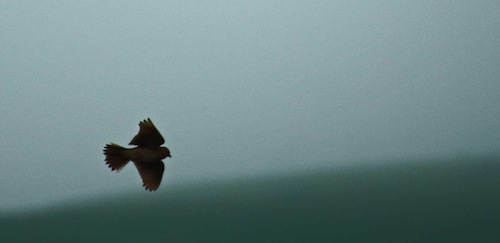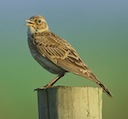 In spring and summer, the skies above the heaths and fields of the Lizard are full of the beautiful song of the Skylark.
In spring and summer, the skies above the heaths and fields of the Lizard are full of the beautiful song of the Skylark.
Photo: © Natural England/P. N. Watts
Scientific name: Alauda avensis
Other common names: Common Skylark, Eurasian Skylark
Cornish name: Ahwesydh
Conservation status: IUCN Red List, Least Concern; UK Birds of Conservation Concern, Red; UK Biodiversity Action Plan, Priority Species.
What to look for:
- Colouring and appearance: Buff breast and pale belly, grey-brown streaked back and streaks also on breast. A small crest on the crown, which it sometimes erects when startled. White edge to wings, most visible when in flight. Males and females are alike in appearance.
- Size: Length 15 to 20 cm, wingspan 33 cm.
- Where: Open habitats, including farmland and heaths across the UK.
- Call: Complex song, heard clearly from high above when the skylark itself may be no more than a black speck.
- Similar species: Meadow pipits also ‘parachute’ while calling, but usually land on branches or rocks/walls, whereas the Skylark always lands on the ground.
“…the crystal lark floats on the Cornish air”
(from Return to Cornwall by Charles Causley)
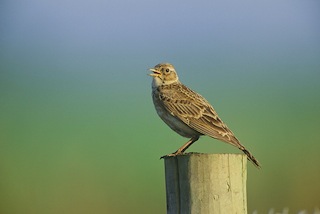
The Skylark has a distribution far wider than Cornwall. Even so, anyone taking a spring or summer walk across the heathlands of the Lizard will identify with Charles Causley’s words as Skylarks, not easily seen on the ground, rise from the heaths with wings spread in their famed songflight. Their beautiful song carries so far and these small birds fly so high (up to 100 m) that it can sometimes take a few moments to find the small dark spot suspended in the sky far above that is the source of the ‘crystal’ notes.
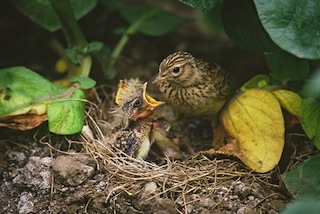 Found on heaths and open farmland across Europe and temperate Asia, the Skylark is a resident breeder across the whole of the UK. The songflight is performed by the male as a territorial display. As he sings he flies vertically upwards and then, after remaining stationary for some minutes on beating wings, slowly parachutes back to earth, finally landing with open wings and disappearing into the vegetation. The breeding season extends from April until August. A pair can raise up to four broods in a good year, with each clutch containing between three and five eggs, laid in a well-concealed nest on the ground amongst the vegetation.
Found on heaths and open farmland across Europe and temperate Asia, the Skylark is a resident breeder across the whole of the UK. The songflight is performed by the male as a territorial display. As he sings he flies vertically upwards and then, after remaining stationary for some minutes on beating wings, slowly parachutes back to earth, finally landing with open wings and disappearing into the vegetation. The breeding season extends from April until August. A pair can raise up to four broods in a good year, with each clutch containing between three and five eggs, laid in a well-concealed nest on the ground amongst the vegetation.
Skylark numbers have declined by some 50% in the last quarter century. The most likely reason is agricultural intensification, which has impacted on the breeding and foraging habitat. The population size of Skylarks was probably fairly small before the introduction and spread of farming by their human neighbours from the Neolithic onwards, and the birds took advantage of the availability of croplands as suitable habitat. This is a species that needs shorter, thinner vegetation in which to breed and forage for its food of insects and seeds. The more recent shift from spring- to autumn-sown crops has not been good for Skylarks, as autumn-sown crops are too thick and tall by springtime, when the birds are nesting, and the practice also means a reduction in stubble, an important source of grain for food, over the winter. Nationally, the RSPB is leading an action plan to conserve Skylark populations, working with farmers and other partners.
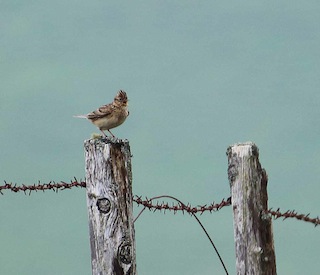
Did you know…?
…Skylarks were the subject of several poems of the First World War – their behaviour of singing from high in the sky meant that they were one of the birds most often seen by soldiers from the trenches. They became a symbol of freedom, and of home.
…The eggs are incubated for 11 days, the shortest incubation period for any breeding bird species in the UK.
More information and references:
Svensson, L., Mullarney, K., Zetterstrom, D.,1986. Collins Bird Guide, second edition (translated by Christie, D., Svensson, L.). HarperCollins, London.
Published: September 2014
Author: Amanda Scott
Photos: Two upper photos (© Natural England/P. N. Watts); lower and below (Amanda Scott)
